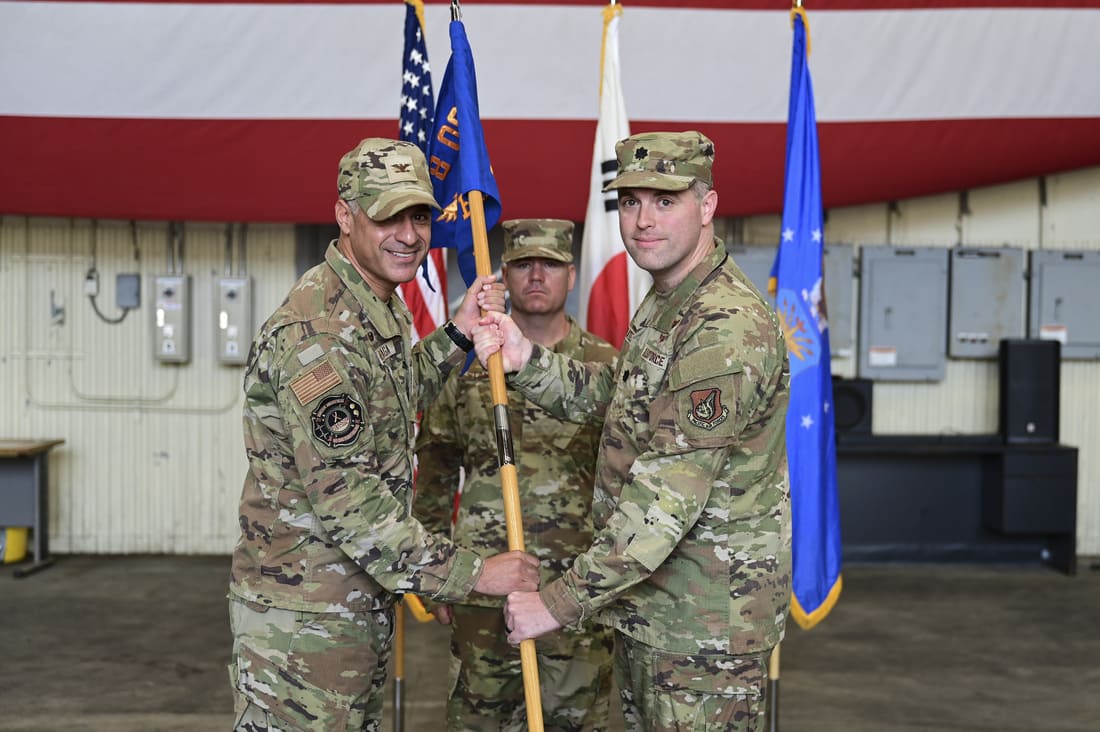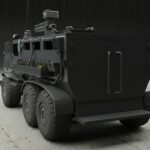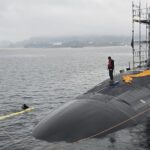The U.S. Air Force reactivated the 431st Expeditionary Reconnaissance Squadron at Kunsan Air Base, Republic of Korea, and assigned it an MQ-9 Reaper mission with permanent basing on the peninsula. A ceremony at Kunsan on September 29 marked the stand-up and assumption of command. The unit falls under the 8th Fighter Wing as a tenant organization.
Lt. Col. Douglas J. Slater Jr. took command of the 431st ERS during the event, receiving the guidon from Col. Ruben Amezaga, commander of the 8th Operations Group. Official photographs and a public release confirm the activation, command handover, and the unit’s alignment to conduct MQ-9 operations from Kunsan.
Statements at the ceremony placed the squadron’s purpose squarely in intelligence, surveillance and reconnaissance across the Indo-Pacific. “Deploying the MQ-9 brings a powerful capability to the region,” Slater said. The unit’s director of operations, Capt. Ryan Jayawardena described the restart as “the next chapter” with Korean allies. These remarks track with the command’s public information and the photos released with the activation notice.
Airmen at Kunsan refer to the host wing as the “Wolf Pack,” home to two F-16 squadrons and now to the MQ-9 tenant. Kunsan sits on Korea’s western coastline near Gunsan City, supporting the Seventh Air Force under Pacific Air Forces. Base records and unit pages list the 35th and 80th Fighter Squadrons as the primary F-16 operators at the installation.
Kunsan Air Base activation details and 431st Expeditionary Reconnaissance Squadron command
Public affairs accounts show the 431st ERS activation and assumption of command occurred September 28-29, 2025, at Kunsan Air Base. The service published multiple images of the guidon transfer and commander remarks, along with a narrative that identifies the squadron as a tenant of the 8th Fighter Wing and specifies its MQ-9 mission. Defense officials confirm the unit will execute ISR tasks in support of U.S.-ROK priorities with the Reaper platform.
The event drew Seventh Air Force public affairs coverage and follow-on distribution through official channels. Photo captions from Kunsan document Slater’s role as commander and repeat the tie to MQ-9 operations. Additional imagery posted through defense media repositories corroborates the date, location, and unit identity shown on the guidon and dais.
Kunsan’s release emphasizes that MQ-9 operations based there will enhance responsiveness for regional ISR tasking. The statement links the squadron’s activation to alliance readiness requirements on the peninsula and across the theater, with language that fits current targeting and reconnaissance tasking. No change in host-wing command relationships was announced. The 431st ERS is nested within existing 8th Fighter Wing structures as a tenant, while remaining aligned to the broader command architecture directed by Seventh Air Force.
Open sources dedicated to aviation developments reported the stand-up in the same timeframe and identified the 431st ERS as the first U.S. unit permanently based in South Korea to operate the MQ-9. Video coverage produced at Kunsan documents the reactivation timeline and the claim that this is the first MQ-9 squadron under United States Forces Korea.
431st Fighter Squadron Hades World War II history and 1992 inactivation
The 431st traces its lineage to the Fifth Air Force in World War II, activated in May 1943 as the 431st “Hades” Fighter Squadron in the Southwest Pacific. Unit histories note P-38 operations in New Guinea and the Philippines, and postwar assignments in the late 1940s. Through multiple redesignations across the Cold War, the squadron flew interceptor and tactical fighter roles before a final redesignation as the 431st Test and Evaluation Squadron, which inactivated in 1992.
Air Force news and historical summaries align on the dates. The service’s contemporary reporting on the reactivation repeats the 1943 origin under Fifth Air Force and the 1992 inactivation after a period as a test and evaluation unit. The link to the F-111 test mission at McClellan and the assignment under the 57th Fighter Wing place the closing years inside the Air Combat Command weapons and test community.
The reactivation restores a unit identifier familiar in the Indo-Pacific theater. The original Hades squadron markings and WWII heritage tie directly to the same region where the 431st now resumes work, though under a very different mission set. The Air Force has used lineage continuity for decades to preserve honors and identity across new technologies and basing decisions. Kunsan’s release explicitly cites the 1943 activation and the lineal connection to the test and evaluation era.
No inconsistencies appear in the open record on the core dates. Secondary pages and enthusiast sites sometimes list interim redesignations with slightly different end dates; official Air Force sources and long-standing reference material converge on the 1992 inactivation of the test and evaluation designation. The current iteration returns the 431st as an expeditionary reconnaissance squadron, missioned for MQ-9 operations out of Korea rather than a stateside test role.
MQ-9 Reaper capabilities, mission and permanent basing in South Korea
The MQ-9A Reaper is a medium-altitude, long-endurance remotely piloted aircraft designed for ISR and strike. Air Force fact sheets put maximum endurance near 27 hours, top airspeed near 240 knots, operating altitudes up to roughly 50,000 feet and external plus internal payload capacity near 3,850 pounds depending on configuration. The aircraft carries electro-optical and infrared sensors, a laser designator and a synthetic aperture radar for all-weather targeting and reconnaissance.
Standard armament includes AGM-114 Hellfire missiles and laser-guided bombs such as GBU-12, while many operators have integrated JDAM families for precision attack. U.S. materials describe the platform as multi-mission with long on-station time for intelligence collection and the ability to prosecute dynamic targets when ordered.
According to industry sources, baseline MQ-9A configurations support endurance of over 27 hours with mission kits and fuel options, paired with block upgrades across power and data links.
The Air Force has previously flown MQ-9s to Kunsan and other regional fields during exercises and rotations. What changes now is basing status. Multiple independent reports and a Defense Department video package identify the 431st ERS as the first permanently based MQ-9 unit in South Korea, replacing a model of rotational deployments used earlier in the decade. That claim appears in synchronized coverage within days of the activation and is restated in official media distributed from Kunsan.
Mission tasking described by the Air Force focuses on ISR across the Indo-Pacific and readiness to respond to emerging threats. The MQ-9’s sensor suite, endurance profile, and datalink architecture match that requirement set. Public statements in the Kunsan release also reference support for humanitarian and disaster response when directed. The new squadron’s posture, with aircraft and crews based at Kunsan, reduces transit to operating areas tied to peninsula defense and regional monitoring.
Osan Air Base F-16 super squadron test and Seventh Air Force posture
Seventh Air Force has been running a “super squadron” test since 2024 to assess generating more combat power with larger fighter squadrons. Phase II began this summer with the movement of F-16s from Kunsan to Osan Air Base, closer to the Demilitarized Zone. Official releases in late July and early August describe the relocation of about 31 F-16s and roughly 1,000 Airmen to Osan for the next phase of the trial. Timelines in those releases target October 2025 for Phase II to be fully underway.
Coverage from Air Force and independent outlets in August and September reiterated the concept: consolidate aircraft and personnel at Osan to test maintenance, logistics, and sortie generation at a larger scale. The service characterized the Kunsan transfers as temporary assignments under the force-optimization test, not a permanent re-stationing of all fighter assets. The context matters for understanding the 431st ERS basing decision: a standing MQ-9 squadron at Kunsan adds persistent ISR capacity while fighter squadrons operate under an ongoing consolidation trial at Osan.
Public materials from Osan and Seventh Air Force give a consistent set of figures on jet and personnel movements, with day-by-day updates as aircraft arrived in late July. Photos and captions by unit public affairs teams confirm arrivals, tail numbers, and unit markings. Those releases frame Phase II as a multi-month test that continues through 2026, while Kunsan’s pages now include a “Newcomers Resources and Super Squadron” section that acknowledges the Osan-focused test.
The MQ-9 unit’s activation fits inside that broader realignment of day-to-day operations. Defense officials confirm the two efforts run on parallel tracks: the F-16 consolidation test at Osan and the permanent MQ-9 presence at Kunsan. Neither announcement describes a change to treaty commitments or command authorities. The practical upshot is straightforward for air tasking: ISR from Kunsan under the 431st ERS and fighter concentration under the Osan super-squadron test.
The 431st’s return also has a lineage dimension. The World War II “Hades” squadron operated across the Southwest Pacific under Fifth Air Force. The modern squadron resumes work in the Indo-Pacific but flies an unmanned platform that did not exist when the unit last inactivated in 1992. Air Force historical references and current reporting align on those dates and underscore the unit’s path from fighter to test to reconnaissance designations across eight decades.
According to industry sources, the Reaper’s payload and endurance envelope allows mixed sensor-weapon loads for long on-station sorties, with block upgrades raising available electrical power and communications capacity over earlier builds. Those configurations have already been demonstrated with U.S. services and allied operators. The public fact sheets posted by the Air Force remain the base reference for endurance, payload, and standard weapons carriage.
Defense officials confirm the 431st ERS will integrate with existing Kunsan support functions and conduct operations consistent with current airspace coordination procedures used by Seventh Air Force. There is no new claim of stealth characteristics or low-observables technology for the MQ-9; the platform’s advantage remains endurance, sensor coverage, and a well-established control architecture. Published fact sheets and program materials do not characterize the MQ-9 as a stealth aircraft.
The permanent basing of an MQ-9 squadron at Kunsan, combined with the F-16 consolidation test at Osan, concentrates crewed fighter mass near the DMZ while anchoring persistent ISR farther south on the west coast. The pairing shortens fighter response times while preserving long-loiter surveillance to feed tasking and battle management.
Airmen and maintainers at Kunsan will absorb the MQ-9’s specific support needs. Program pages and official fact sheets list the usual weapons – Hellfire missiles and GBU-12 laser-guided bombs – with JDAM options documented across operators.
The unit’s resumption in the Indo-Pacific follows a pattern the Air Force has used elsewhere, assigning historic lineages to modern missions to maintain continuity of honors and identity. The 431st ERS now carries that banner at Kunsan as an MQ-9 outfit with a defined ISR role tied to Seventh Air Force tasking.
REFERENCE SOURCES
- https://www.kunsan.af.mil/-Wolf-Pack-News/Display/Article/4316744/431st-expeditionary-reconnaissance-squadron-activates-hosts-assumptions-of-comm/
- https://www.dvidshub.net/video/984003/431st-expeditionary-reconnaissance-squadron-reactivates-kunsan-ab
- https://www.defensenews.com/news/your-air-force/2025/09/30/wwii-era-squadron-reactivated-as-mq-9-reaper-drone-unit/
- https://www.airforcetimes.com/news/your-air-force/2025/09/30/wwii-era-squadron-reactivated-as-mq-9-reaper-drone-unit/
- https://theaviationist.com/2025/10/02/usaf-mq9-reaper-unit-south-korea/
- https://thedefensepost.com/2025/09/30/us-reaper-south-korea-squadron/
- https://www.af.mil/About-Us/Fact-Sheets/Display/Article/104470/mq-9-reaper/
- https://www.navair.navy.mil/product/MQ-9A-Reaper
- https://www.ga-asi.com/images/products/aircraft_systems/pdf/MQ9%20Reaper_Predator_B_032515.pdf
- https://pacificwrecks.com/unit/usaaf/475fg/431fs.html
- https://en.wikipedia.org/wiki/431st_Test_and_Evaluation_Squadron
- https://www.osan.af.mil/Home-Page-Reimagined/
- https://www.airandspaceforces.com/osan-f-16-second-super-squadron/
- https://www.stripes.com/branches/air_force/2025-08-01/f16-super-squadron-south-korea-18632502.html
- https://www.af.mil/News/Article-Display/Article/4260525/f-16s-relocate-to-osan-ab-as-super-squadron-test-prepares-to-enter-phase-ii/
- https://ipdefenseforum.com/2025/09/u-s-air-force-testing-super-squadron-in-rok/
- https://www.kunsan.af.mil/About-Us/Fact-Sheets/Display/Article/412721/kunsan-air-base/
- https://www.kunsan.af.mil/-Wolf-Pack-News/Display/Article/3632119/the-wolf-pack-sustains-operations-around-the-clock/



